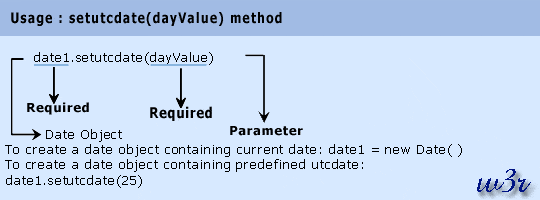JavaScript setUTCdate() Method: Date Object
Description
The setUTCdate() method is used to set the numeric day of the month according to Coordinated Universal Time (UTC).
Version
Implemented in JavaScript 1.3
Syntax
setUTCdate(dayValue)
Parameter
dayValue: An integer from 1 to 31, representing the day of the month
If the specified parameter is outside the expected range, setUTCDate try to update the date information in the Date object accordingly. For example, if you use 37 for day value, and the month stored in the Date object is April, the day will be changed to 7 and the month will be next of April i.e. May.

Example:
In the following web document the day of the current month sets with various values with setUTCDate() method
<!DOCTYPE html PUBLIC "-//W3C//DTD XHTML 1.0 Transitional//EN"
"http://www.w3.org/TR/xhtml1/DTD/xhtml1-transitional.dtd">
<html xmlns="http://www.w3.org/1999/xhtml" xml:lang="en" lang="en">
<head>
<meta http-equiv="content-type" content="text/html; charset=iso-8859-1" />
<title>JavaScript date object - setUTCDate() method example</title>
</head>
<body>
<h1 style="color: red">JavaScript date object : setUTCDate() method</h1>
<hr />
<script type="text/javascript">
//This is done to make the following JavaScript code compatible to XHTML. <![CDATA[
user_date = new Date()
document.write("Current Date : "+user_date+"<BR />")
user_date.setUTCDate(20)
document.write("Changing the current date to 20 : "+user_date+"<BR />")
user_date.setUTCDate(188)
document.write("Changing the current date to 188: "+user_date+"<BR />")
//]]>
</script>
</body>
</html>
View the example in the browser
Supported Browser
| Internet Explorer 7 | Firefox 3.6 | Google Chrome 7 | Safari 5.0.1 | Opera 10 |
| Yes | Yes | Yes | Yes | Yes |
See also:
JavaScript Core objects, methods, properties.
Previous: JavaScript setTime()Method: Date Object
Next: JavaScript setUTCfullyear() Method: Date Object
Test your Programming skills with w3resource's quiz.
